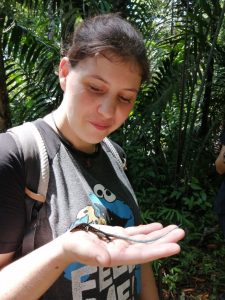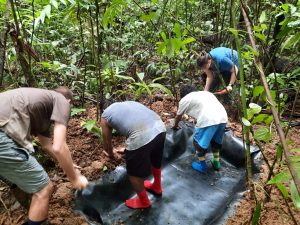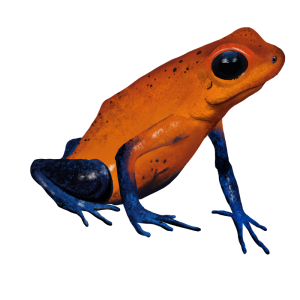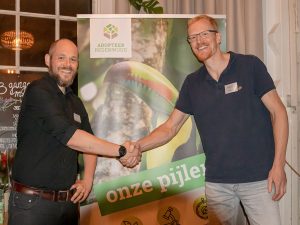Zoë on her wonderful experiences as a volunteer in Costa Rica
And then there you are, atop a hilltop, having a good cry. Or frantically trying not to let your fellow volunteer see how touched you are. My name is Zoë, I live near Hasselt in Belgium. I am an adult education teacher, and enthusiastic but very novice when it comes to nature. I would like to tell you about my wonderful experiences as a volunteer in the reserve of Adopt Rainforest.
Toddler of a forest
Ivan, another volunteer who helped with the foundation’s reforestation project for three months, asked me if I wanted to go with him to the latest reforestation plot. Of course I wanted to! I had already seen the old patch where trees were planted five years ago, where, to the untrained eye, there was just a patch of rainforest to be seen, despite the fact that 5 years earlier it was bare pasture there. It seemed impossible to believe. In Belgium, where there is no shortage of rain either, a tree hardly grows in 5 years. And there I was, in a real forest. Not little shoots, but big trees, with lianas, hiding places for frogs and colorful butterflies and so much more. I have been along several times on censuses for the foundation’s long-running biodiversity study. Even though I know absolutely nothing about species identification, there is nothing like hearing a bunch of connoisseurs enthusiastically yell to each other that they see that one butterfly species they’ve only seen once, sitting further down the path there! I’ve watched the wildlife cameras placed in this newly planted forest several times, and it’s wonderful how many mammals have found their niche by now, too, in this toddler of a forest.
The Beast
So of course I wanted to come along to the new stretch where a total of 27,800 trees are being planted. So off we went with “The Beast. And if you now imagine us galloping heroically through the jungle on the back of a jaguar with our hair in the wind, I have to disappoint you slightly. ‘The Beast’ is the car of the local local foundation, a 4×4 with some miles on the clock. The steel steed that sometimes seems to hang together from superglue, dust and good spirits, but still manages to take you to the most beautiful places without fail. The last time I rode along, there was even a salamander hitching a ride.
We drove for quite a while at 15km/h on dirt roads, stopping along the way to spot some beautiful views and birds. These included a couple of Caracara. The Caracara is a bird about half a meter tall from the falcon family. Not only impressive to see, but secretly I also found it a bit hilarious. Because the name Caracara, is like literally yelling “face-face” in Spanish at a bird.
After some driving, we left “The Beast” on the side of the road and climbed a hill. We briefly passed by Robert, who is the foreman of the group of tree planters. Both he and the eight other workers are all original inhabitants of the adjacent Indian reservation. Then we continued to the top of a hill. Along the way we saw a small tree sticking out of the ground every few meters. Still so small and fragile, no higher than your knee, as wide as your finger. Some were already being eaten by leafcutter ants, who eat an entire tree bare in no time. Again, impossible to imagine this will be a forest in 5 years, yet it is!
Natural corridor
Ivan pointed to the Barbilla National Park, the foundation’s old reserve and the recently acquired reserve. He explained how this plot where reforestation is now taking place will make the connection between the foundation’s reserve and the national park. A natural corridor for trees, plants and animals. With this corridor, there is less fragmentation, making it easier for animal species to move around in search of food or shelter. This leads to more cross-pollination and thus less inbreeding.
Hope
Anyway, so I’m standing on that hilltop with my feet in the grass, looking at the surrounding stretches of meadow and rainforest.We stopped talking, but you can’t call it quiet.It’s rarely quiet in the rainforest. You are always surrounded by birdsong, crickets, croaking frogs, calling salamanders. And in my head the news is playing in the background. Because sometimes I make the mistake of watching the news. This summer was another very pernicious one, climate-wise. One where one half of the world was on fire, and the other half flooded. My heart breaks at seeing news reports like this, and my cherished naivete that we can make everything right is sometimes hard to maintain. I hesitated for a long time about going to Costa Rica, as I have an appropriate amount of flight embarrassment, but still wanted to see all this beauty for myself. And where possible, even lend a hand. And there, on that hilltop, looking at all that potential, my heart healed itself a little. It’s hard to describe, but there, in that moment, there was suddenly a world of hope. Some 25 acres, or around 50 soccer fields of pure hope.The beauty overwhelmed me, and my eyes grew moist. Because if we can plant 27,800 trees here from a foundation founded by two Dutch guys, and already protect 240 hectares of rainforest, then anything is possible.
On the way back, I talk to Ivan about ecology, the projects the foundation is doing here and flight embarrassment. And for a moment I’m not the only one, who doesn’t quite fit into this world.No longer the only naive soul who doesn’t understand how the world always seems to go on and on, when paradise does exist and we just need to keep and restore it.
Dreams and goals
I didn’t plant any trees myself, but I did help dig three frog pools in the reserve under the expert guidance of local guides Hurben and Gerald.The first three of a total of 10 Frog Pools designed to give endangered frog species some additional habitat and breathing room.And as I push today’s tenth mosquito to death and rub off a layer of sweat, I stick my shovel into the ground once again. Because how cool is it, that 5 years from now a new group of volunteers and students will be strolling through this piece of paradise, hearing how several endangered frog species have been successfully reintroduced here. Just as I have heard all these cool stories about what the people before me have accomplished here. A chain of people, connected by that same wonder and fascination. Connected by those same dreams and goals. Connected by those same trees and plants, only about five years bigger and older. And that was exactly what my heart needed!
Would you also like to contribute as a volunteer to our project in Costa Rica? Then take a look at the website www.studytherainforest.com

 on with Utrecht University. The foundation was ready for a new step to professionalize the research project and Utrecht University was looking for a stable and reliable partner in Central America to conduct solid research in the rainforest. So for both parties this is a wonderful collaboration! Because of this we will make a big step in professionalizing our current research on biodiversity in our reserve. Together with the visiting students we will focus on scientific research in which the diversity and development of nature in our reserve, with an emphasis on flora, is central.
on with Utrecht University. The foundation was ready for a new step to professionalize the research project and Utrecht University was looking for a stable and reliable partner in Central America to conduct solid research in the rainforest. So for both parties this is a wonderful collaboration! Because of this we will make a big step in professionalizing our current research on biodiversity in our reserve. Together with the visiting students we will focus on scientific research in which the diversity and development of nature in our reserve, with an emphasis on flora, is central.